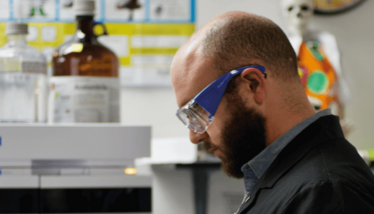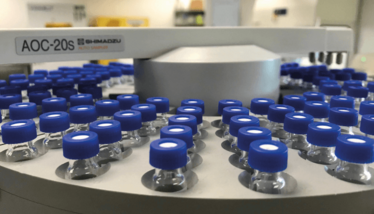
Ask the Experts: What’s Next for Cannabis Analysis?
Analytical experts Swetha Kaul, Jeffrey Raber, Julie Kowalski and David Dawson discuss how testing labs must adapt to meet the needs of a rapidly evolving industry
The cannabis and cannabinoid market is diversifying. Why smoke a joint, when you can nibble on cannabis-infused artisan truffles, discreetly vape vanilla-flavored THC e-liquids, or sip on CBD wine? But when product innovation outpaces regulation, quality and safety can suffer.
As cannabis products and quality standards evolve, analytical labs are tasked with testing an increasing number of attributes – from tracking the stability of novel water-based formulations to assessing the risk from heavy metals in packaging.
What challenges do novel products pose for testing labs? And how will cannabis analysis adapt and grow in response to the demands of an increasingly sophisticated market? We sit down with four analytical experts from the USA’s most established legal cannabis markets to get their vision of cannabis analysis 2.0.
Meet the Experts

Swetha Kaul
Swetha is Vice President of the Board of Directors at the California Cannabis Industry Association, before which she was CSO at Cannalysis Labs. After earning her PhD in analytical chemistry from the University of Kansas, she started her analytical career in the pharmaceutical industry, spending six years at biotech Allergan before making the switch to the cannabis testing industry in 2017.

Jeffrey Raber
Jeff is an entrepreneur and the co-founder and CEO of The Werc Shop, which started out as a cannabis testing lab and now offers consultancy services to help licensed cannabis businesses develop innovative new products. With a PhD in chemistry from the University of Southern California, Jeff spent nearly a decade in the fine chemicals industry before founding The Werc Shop in 2010.

Julie Kowalski
A highly experienced analytical scientist, Julie works as an independent scientific consultant to the cannabis industry. Having gained her PhD in analytical chemistry, she started her career at chromatography products manufacturer Restek before joining cannabis lab Trace Analytics as Director of Science and Research and later Chief Scientific Officer.

David Dawson
David is a Research Scientist at cannabis infusion technology company Vertosa; previously, he was the Research Principal at California cannabis testing lab CW Analytical. He has a special interest in cannabinoid testing in edibles, and serves on the scientific committee of the Emerald Conference. David gained his PhD in organic chemistry from UC Irvine.
How has the cannabis testing field changed in recent years?
Swetha: The most obvious change here in California is of course the introduction of state regulations covering various safety and quality parameters. In the early days of regulation, there was much debate over what instrumentation and what approach you should use for certain analyses but those questions are slowly being answered. Outside of regulatory testing there is still a vast uncharted territory to cover, however!
David: Testing in the black market days was superficial and mostly for marketing purposes; producers would submit products for cannabinoid testing to prove they were more potent than the competition, or commission a meager pesticide survey just so they could label their product “Pesticide Free!” Now, with a few years of regulated testing under our belts, producers and testing labs alike are learning the nuance behind testing the wide array of products available, and the best ways to troubleshoot failing tests or batches.
Julie: In recent years it’s been great to see standards organizations like AOAC International starting to engage with cannabis testing in earnest. I think consensus methods are desperately needed and will benefit the whole market so I was delighted to see AOAC launch an official cannabis analytical science program (CASP) last year.
Have you noticed a trend for more diverse cannabis products?
Jeff: Creativity and innovation abound in this industry and there has definitely been a trend toward greater product diversity, especially in edibles like gummies and chocolates.
David: Absolutely. Where once edibles were a choice between cookies, brownies, chocolate, and rudimentary gummies, we now see powdered drink mixes, infused bake-at-home brownie kits, smoked meat jerky, marshmallows, pressed ‘breath mint’ style candies. One area that seems to have taken off in the last year is cannabis-infused beverages. Though they’ve been on the market for a while in various forms, cannabis producers are finally starting to nail down the science behind making cannabinoids water soluble, which opens up a vast new field of stable, low-dosage cannabeverages.
Swetha: With the EVALI outbreak last year and subsequent drop in sales of vape products, consumers are turning increasingly to edibles and beverages. Unfortunately for testing labs, these are some of the most complex products to analyze, with a high number of matrices! We now see very similar methods across labs for flower, concentrates, and tinctures but we’re still a long way from interlaboratory consistency for edibles and beverages.
Julie: After my first year working for a cannabis lab, I stopped being surprised by anything that came through the door! You might think you have every product type covered but then you get a cannabis toothpaste submitted for analysis, and have to go back to the drawing board. I agree with the other panelists that beverages are a definite growth market, with a lot of companies touting water-soluble technology, such as “nano CBD.”

What challenges do these new product types pose for cannabis testing labs?
David: As we still have no federal guidelines for testing methods, or even consensus in the scientific community, every time a new product type comes in for testing we have to start from the ground up to a certain degree. For example, marshmallows might seem similar to gummies, but we can’t know for certain that a marshmallow matrix should be treated exactly the same as a gummy matrix.
Jeff: I agree – as product diversity expands, the technical challenge grows more complex. A specific challenge with edibles is that the sensitive LC-MS instruments used to detect low levels of pesticides aren’t suited to “dirty” or complex matrices so the samples can require extensive cleanup. The more cleanup you do, the more risk there is that you will remove some of the pesticides as well. And when you have 60 to 100 different pesticides to look for that becomes a pretty complicated problem...
Swetha: For beverages, the central problem for manufacturers is that consumers prefer water-based beverages, but cannabinoids are not water soluble. There are a number of ways to get around that issue, by emulsifying or encapsulating the cannabinoids, but in formulating a drink the manufacturer will be thinking about the consumer’s enjoyment, not the ease of testing. That’s understandable but, as David and Jeff note, with so many ingredients in the formulation, separation becomes much more complicated.
Julie: From a testing perspective, beverages are particularly challenging because most standard methods are designed for free analytes – not for encapsulated or emulsified products. You have to figure out a way to disrupt those particles, and that will differ according to the method used. Sometimes your customer may not even know exactly how the particles are formed, having bought-in the technology from a third party. Other companies may not want to share that information because it’s proprietary technology. You end up having to do some R&D work, which can be fun, but also challenging in a fast-paced commercial laboratory.
What has been one of your most challenging samples?
Julie: Cannabis shampoo was a memorable one – my heart sank when that arrived in the lab! The manufacturer wanted a cannabinoid analysis, and shampoo is obviously full of surfactants, which dissolve in almost any solvent and could damage our instrumentation. I had visions of bubbles pouring out of the LC column! All went smoothly in the end but that was a stressful day.
David: Last year, I published data on cannabinoid concentration testing in cannabis-infused chocolate products (1), which revealed a large degree of nuance. Multiple factors, such as amount of chocolate product present, amount of cocoa solids present, and several structural features of the cannabinoid analytes can affect recovery. These findings suggest that each specific type of product may have unique idiosyncrasies that must be teased out before we can truly consider a prep method “optimized.” As there is essentially no cannabis testing research coming out of academia, it will fall to the testing labs to work on these issues and push the field of commercial cannabis testing towards scientific legitimacy.
Jeff: I actually read David’s paper on measuring cannabinoids in chocolates with great interest. Chocolate is an excellent example of how edible matrices can create challenges, because the fats in the chocolate bind the cannabinoids and give artificially low THC values. We’ve seen a similar problem with certain types of gummies. In fact, in some cases the gummy matrix holds on to the cannabinoids better than the extraction matrix. But I’m very glad that I’ve never had to try to analyze shampoo!
Swetha: Another challenge with beverages and edibles is that the dosage tends to be a lot lower than flower, concentrates, or tinctures. And that doesn’t give much room for dilution to overcome matrix effects. If you’re hitting the sensitivity limits of your UHPLC-UV method and can’t dilute, you’re faced with investing in an expensive mass spectrometer to boost sensitivity – and that may not be cost-effective
What is your advice for analytical labs when working with a new or unusual product?
Jeff: Each product has its own requirements, but my advice for labs is to work as closely with your manufacturer as possible. The ideal way to work is what I call “bottom up” testing – when we know and verify exactly what went into each manufacturing step and how much cannabinoid should be in the end product.
In reality, we often work from the top down – measuring cannabinoid levels from a sample of the final product, with limited background information. In these circumstances, if you measure 7 mg of THC and the client says they added 12 mg, it can be hard to trace the root of the problem, especially if the manufacturer refuses to share information on their process or provide additional samples.
With this in mind, my advice to manufacturers would be to work under confidentiality agreements if you are concerned about trade secrets, but be willing to put some trust in your lab too. Pick a lab with great care, and invest in building a relationship with them – a stronger partnership benefits both parties and will be more fruitful in the long term.
Swetha: I agree that open communication is the best approach. If possible, ask the manufacturer to provide a sample of the same matrix without the cannabinoid infusion. If you have a true blank, it gives you the option to do spiking experiments to identify matrix effects.
Julie: Like most analytical chemists, I’m a fan of having a formalized process and standard operating procedures, and I think it’s important to build in some checks for any new matrix. When turnaround time is tight, it’s tempting to skip verification but that’s simply not an option if you want to do quality science – even though it can be difficult for clients to understand.
David: Every time you are faced with a new sample type (even if it seems similar to a previous product), you need to ask yourself a number of questions. Are you testing it in the most efficient way possible? Are you minimizing matrix effects? How can you ensure homogeneity when sampling a large number of units from a given batch? Is the producer able to reliably make this product from batch to batch? With no widely accepted standardized methods, a new product might have any number of quirks that make it unique from what you’ve tested before.
What tests are labs doing now that they weren’t doing five years ago?
David: In California, the state regulations mandated that we add new analyses, such as heavy metals and mycotoxin screens. Because of the new analyte list and required LODs/LOQs, many tests that were sufficient five years ago had to be developed from scratch. This relatively recent trend for greater precision carries over to much of our daily work; now that the cannabis market has been made official, the stakes are higher for all analyses, and we must rise to meet the occasion.
Swetha: Cannabis testing is still very much driven by regulation. For some analyses, regulation has led to more extensive testing with more sophisticated instruments. However, there can be an unfortunate side effect of regulation – companies only have so much money to spend on testing, so optional tests have been cut. I’ve seen a drop in terpene testing in California, which is a shame because there’s a lot of really good information we can get from the terpene profile and I believe consumers benefit from knowing what terpenes are in the product.
Julie: The core analyses are still pretty much the same, but some of the methods are becoming more sophisticated. For example, labs might invest in a Q-Trap mass spectrometer for pesticide analysis, rather than a triple quad. With experience, people have come to understand how tough it is to test pesticides to the levels required and are more likely to invest in a certain level of instrumentation straight out of the gate, rather than trying to make do with something cheaper.
Jeff: Organism-specific microbiology testing using qPCR is another example of evolution in methods. Up until quite recently, a lot of people were still using traditional plating and looking at broad classes of organisms instead of specific pathogens, so that has been a welcome improvement.
What analyses do you think will become more widespread in future?
Swetha: Right now, we’re still getting used to the regulations, but I hope with time we will see a shift to using labs not only for routine regulatory testing, but to validate manufacturing processes. I suspect the future for cannabis producers lies in good manufacturing practice (GMP)-based production, which requires a lot of in-process testing to validate processes and ensure consistency. Cost is always a barrier but this type of analysis could pay for itself by making processes more efficient.
David: I can see shelf-life/stability studies becoming important in the next few years. At present, much of the industry is still in a quick turnaround mindset but, as the market expands and as buyers are presented with more options, cannabis products may spend longer on shelves or be held in warehouses. We will need products that are stable at room temperature for months, or even years, without potency loss or flavor degradation.
Looking further ahead, perhaps a decade or more, I can envisage bioavailability studies being carried out when designing a new product. If labs are able to show how fast a product will hit the bloodstream and cause the desired effect, the overall user experience can be standardized. Both stability and bioavailability tests are commonplace in the food and pharmaceutical fields, and there’s no reason to think that they won’t be adopted in the cannabis industry at some point.
Julie: I think regulatory testing will inevitably expand over time. If there’s another incident, like EVALI, that results in people getting sick or if there’s a study that shows the danger of a component, there will naturally be a reaction from the government agencies that are tasked with protecting human health.
I think we need more research and testing that is specific to smoked products, as the method of consumption is given very little consideration at present. We may see smoke studies or specific tests to understand what happens to pesticides during combustion.
Jeff: A more unusual type of analysis that might be coming down the track is “appellation of origin” testing – to confirm that a cannabis product comes from a specific region (just as a sparkling wine must come from the Champagne region of France to be called Champagne). An appellation scheme being introduced in California will allow growers in specific regions to market their products as “Humboldt-grown,” for example. In the short-term this is likely to rely on track and trace technologies, but the addition of chemotypic profiling could add a more definitive “fingerprint” to establish veracity.
The bigger changes will probably lean towards adulterants; for example, metals introduced during growing, silicon dioxide used to add weight, and even psychoactive additives like synthetic cannabinoids.
Does regulation need to evolve?
Julie: There are still striking inconsistencies in current regulations. For example, in some states, private labs only need to offer testing for a handful of pesticides to be licensed as cannabis testing labs. But when doing inspections, the state uses an internal lab that can test for hundreds of pesticides. Growers are left in a frustrating position, unable to proactively test to the standard the state holds them to.
State governments were handed the task of building a regulatory framework from scratch, with no input from federal agencies – a daunting task. It’s been a steep learning curve but now we’re a few years down the line I hope growers, testing labs, and regulators can come together to create a system that works for everyone.
Swetha: There’s a natural friction between producers and testing labs. Too often growers and manufacturers look at testing as a hurdle that you have to get through, rather than a means to achieve better quality. I’ve seen that attitude change slightly over the years, but we need to do more to bring the different parts of the industry together.
Jeff: I predict we’ll continue to see a great deal of regulatory change over the next 5–10 years. First and foremost, we need better enforcement of regulation at the level of individual labs, to make sure that they’re accurate and honest. Anecdotally, “gaming the system” is still rife. To date, most regulators have lacked the resources or appetite to tackle the problem but as more states come online, regulators are comparing notes and developing longer-term goals.
Currently, we only label for THC and CBD, but there is increasing interest in minor cannabinoids. A product that contains only CBG and CBN is still a cannabis product, and the active ingredients should be labeled. I can see us eventually having to identify a much larger number of cannabinoids quantitatively; for example, regulators may decide that 90 percent of the cannabinoid content has to be accounted for.
David: I agree with Jeff that there needs to be better enforcement of existing law at all levels. In California, testing labs frequently are the enforcers of the law, pointing out inconsistencies with batch ID numbers, faulty label claims, and so on; as such, cannabis producers can view us as the enemy, and a barrier to them getting their products to market. My view is that enforcement should be carried out by state agencies, and testing should be a streamlined process to determine if the data matches the law.
Plus, legislation protecting small scale growers and producers should be introduced (a “farmers market provision”) to protect the rich history of small-batch cannabis production.
What are your hopes and fears for the future of the industry?
Swetha: We need to reach a position where we’re focused on the quality of the products rather than the speed with which we’re getting to market. My ultimate hope is that manufacturers learn to look at testing not just as a regulatory requirement but as something that can help you produce a better product and be more profitable.
My fear is that if we take too long to get there, we might lose some good labs along the way. Some smaller labs with high scientific standards are struggling to meet pricing and turnaround pressures.
David: I hope the industry can continue to lean into the scientific method and collaboration on issues facing us all. For the most precise, accurate, and robust testing methods to emerge, we must work together to figure out these unknowns.
I fear that without proper oversight from governing bodies, cannabis analytical labs may continue to operate as data farms, giving clients the numbers they want.
Julie: I’d like to see the testing community adopt an attitude of openness and transparency on the science we do and the challenges we face. We cannot learn from each other if we don’t tell each other what we’re doing. And we can’t work together to find solutions if we will not admit the problems we’re having. On the whole, the reputation of cannabis testing could be much improved, and we can only do that by working together.
My fear is a serious safety incident like EVALI coming out of the industry, which would be tragic for everyone concerned and could set the industry back years.
Jeff: I’m excited about continued innovation, new products, and better formulations for cannabis to improve health. I just hope the regulators can keep up. Like Julie, my fear is that laws and regulations will fall behind product innovation to the point that consumers are harmed by unregulated additives or something unforeseen and much worse...
- D Dawson, RW Martin, J Agric Food Chem, 68, 20, 5699 (2020). DOI: 10.1021/acs.jafc.0c01161












